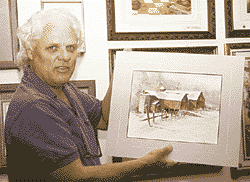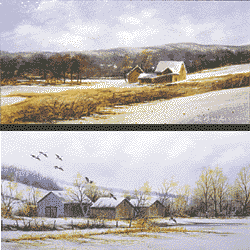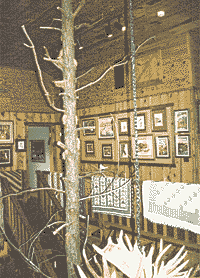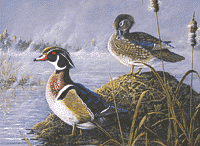While the region's natural beauty is apparent to many, few are able to express their appreciation as well as the wildlife artists that live and work here in Northwest New Jersey.
Wildlife is an important component of Al Barker's work, but his paintings often portray scenes and subjects extending into a broader realm that includes sporting (hunting and fishing) art and landscapes. "People will ask 'What are you going to paint next?' I try to tell them that I'll paint just about everything" explains Barker. His work is "all over the place" by design, accordant only in its intent for the unique. "When people buy my work, it's because they like it; not because it's a portrait of any specific thing."

When his rendering of a jumping bass won a contest in his Montclair 8th grade class, Al's teacher encouraged him while advising that he root himself in a complementary profession. Barker went on to study forestry, earning a Masters in horticulture and a fellowship for Doctorate work. His academic training and a 12 year teaching career lent him the discipline with which he credits 25 successful years as a professional artist.
Barker does a little bit of everything-- all well, and lots of it. "The thing that keeps me going is the fear of failure. I've seen lots of professional painters give up because they're not disciplined." Fifty oils already this year, scattered among watercolors and etchings of all sizes, have found their way to galleries and homes across the country. He does three major shows a year and is a Hall of Famer at the Easton, Maryland, Waterfowl Festival, having exhibited there since it began 20 years ago. Al insists that he's "too old to chase shows," but his work can be found in almost every National Miniature Exhibition in the country.
 Although
Barker's art comes in all sizes, from 4x5 to 30x36, his enormous
output in miniature seems to reciprocate his philosophy about keeping
his work affordable. He would much rather see four people own $250
paintings than one have a $1000 piece. And miniatures allow Barker
to keep pace with the rapid flow of his ideas. Miniatures also
allow him to paint specific subjects pertaining to the location
of each show.
Although
Barker's art comes in all sizes, from 4x5 to 30x36, his enormous
output in miniature seems to reciprocate his philosophy about keeping
his work affordable. He would much rather see four people own $250
paintings than one have a $1000 piece. And miniatures allow Barker
to keep pace with the rapid flow of his ideas. Miniatures also
allow him to paint specific subjects pertaining to the location
of each show.
Because his themes differ so widely from painting to painting, it's difficult to identify a Barker except by the trademark tiny red specks he uses in "negative" space. Most influenced by Milton Weiler and Don Stone, Barker's approach is to "paint light, not things. My favorite piece is always the last one I did." He'd prefer that people not linger over favorites either. "After completing a painting I want people to say to themselves 'I have been there and seen that'."
You can find Barker's work at the Decoys & Wildlife Gallery and Gabriele's Gallery in Frenchtown.
 When
you enter her home, just north of Branchville in Sussex County, you quickly
begin to understand Carol Decker. She and her husband Roy built the house,
modeled after a trapper's cabin, from foundation to rafters. One large
central room, anchored by a 30 foot trunk of a pitch pine that rises
past the second floor loft to the hemlock ceiling high above, bursts
with paintings and prints hung and stacked beside the board and batten
rough-cut walls. At first glance, this is the artist's showroom. Indeed,
many come here to buy work published and framed by the Deckers. A second
look reveals that this is also the couple's living room, dining room,
bed room and kitchen, handmade from stairway to bed posts. Further, the
home's openness reflects the character of the artist and her work.
When
you enter her home, just north of Branchville in Sussex County, you quickly
begin to understand Carol Decker. She and her husband Roy built the house,
modeled after a trapper's cabin, from foundation to rafters. One large
central room, anchored by a 30 foot trunk of a pitch pine that rises
past the second floor loft to the hemlock ceiling high above, bursts
with paintings and prints hung and stacked beside the board and batten
rough-cut walls. At first glance, this is the artist's showroom. Indeed,
many come here to buy work published and framed by the Deckers. A second
look reveals that this is also the couple's living room, dining room,
bed room and kitchen, handmade from stairway to bed posts. Further, the
home's openness reflects the character of the artist and her work.
From her working studio, a small room off one end of the "great" room, Carol has produced an astounding volume of work that includes not only fine art paintings but work for limited edition prints, books, posters, wildlife stamps and collector plates. Carol's larger "studio" exists in the woods and forests- mostly in Northwest New Jersey- where she has spent countless hours studying wildlife in the field. Journals full of written observations and rough sketches become finished product at home, where Carol and Roy, married for 40 years, have created the most elegant of cottage industries.
Soon after the Deckers came to Sussex from Paramus in the early 1970s, Carol ventured out with her art. Her first success was at Space Farms, where her painted birds on cedar shingles sold like hotcakes. At the 1977 Sussex County Farm and Horse show, Bob McDowell, later Director of NJ Division of Fish, Game and Wildlife, saw Carol's work and began an enduring relationship. Since then Carol's artwork and Roy's photographs have appeared in many of the Division's publications and educational exhibits.

In 1978, a series of Carol's paintings began to appear in New Jersey Outdoors magazine along with articles written by biologists and educators about wildlife in New Jersey. Seventy-eight paintings later, the series was collated in a book, New Jersey Wildlife Profiles, which serves both as a comprehensive summary of Carol's work and as a superb survey of the state's natural treasures. McDowell writes in the volume's introduction, "Carol's ability to see, understand and illustrate details of the animals, their habitats and their relationship with people is what makes the entire presentation so popular. It is an extremely effective method of teaching and informing people about the values of this natural resource." It is love of her subject that makes Decker so intent on sharing the enchanting details.
Carol started painting at age 11, copying the masters, yearning to paint animals. It his her early training with which she credits her ability to easily mix colors and work quickly. "Around the art work" she says, "I do the other things that support the educational and environmental connections that are important to me." Her move to acrylics was important because it "drys as fast as I need to do it. I use oil when I have time to 'play.'"
Decker's paintings tell stories: An owl bewildered by the size of her family in "So Many Children" or a young buck contemplating a fallen antler resting in the snow in "Heritage". Or stories of color like the indigo bunting and fringed gentian flower sharing an early autumnal brilliance in "September Blues". Whatever the subject, Carol continues to grow and learn. "Letting go of the clutching feeling I've had in relationship to my work has been important. I'm grateful and I'm blessed, and there's lots to do."
You can see Carol Decker's work at scheduled shows in the area. Or you can make an appointment to see Carol and her work at 973-948-5597. Or check her website